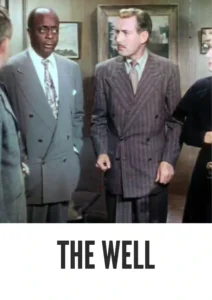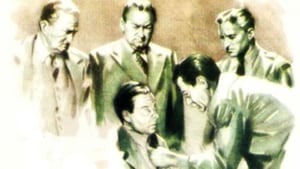Contact: info@alwanfilm.com
Video Sources 0 Views

The Well 1951 Colorized
Synopsis
Review: The Well 1951 Colorized – Exploring the Impact of Early Colorization

Introduction
In the annals of film history, “The Well” from 1951 stands as a compelling and socially significant piece of cinema. Directed by Leo C. Popkin and Russell Rouse, this film dives deep into the complexities of racial tensions in mid-20th-century America. With its recent re-release in an early colored version, “The Well” has reignited discussions about the impact of colorization on classic films. In this article, we will explore the effects of colorization on “The Well” and discuss its importance within the broader context of film history.
Check The Full Colorized Movies List
Check Our Colorized Movies Trailer Channel
Understanding The Well 1951 Colorized: Director, Cast, and Genre
“The Well” is a collaborative effort by directors Leo C. Popkin and Russell Rouse, who aimed to create a film that addressed pressing social issues of their time. The cast features Richard Rober as Sheriff Ben Kellogg, Gwendolyn Laster as the young Carolyn Crawford, and Harry Morgan as Claude Packard. This ensemble brings to life a tense narrative that combines elements of crime drama and social commentary.
The film’s genre straddles both crime drama and social realism, a reflection of its intent to portray a real-world issue within an engaging and suspenseful storyline. The directors’ vision was to create a film that not only entertained but also provoked thought and discussion on the deep-seated racial prejudices of the era.
Exploring the World of The Well 1951 Colorized: Plot and Characters
“The Well” centers around the story of Carolyn Crawford, a young black girl who falls into an abandoned well. Her disappearance sparks panic in the small town, leading to a series of misunderstandings and racially charged tensions. The narrative unfolds with Sheriff Ben Kellogg trying to maintain peace while a search and rescue operation is underway.
Key moments in the film include the initial search for Carolyn, the escalating racial tensions, and the eventual resolution that brings the community together. Characters like Claude Packard, a white man wrongfully accused of kidnapping Carolyn, play pivotal roles in highlighting the prejudices and fears that drive the town’s unrest.
The Art of Film Colorization
Film colorization, the technique of adding color to black and white films, has been a topic of debate since its inception. Proponents argue that it brings new life to old classics, making them more accessible to modern audiences, while critics contend that it can undermine the original artistic vision and historical authenticity.
The process of colorization involves several stages, including digitally mapping the black and white footage, selecting appropriate colors, and meticulously applying these colors to create a natural look. When executed well, colorization can enhance the viewing experience without detracting from the film’s original charm.
Early Colored Films: A Brief History
The history of color in cinema dates back to the early 20th century, with techniques such as hand-coloring, tinting, and toning being used to add visual appeal to silent films. With the advent of Technicolor in the 1930s, filmmakers were able to create vibrant, fully colored movies that captivated audiences.
Early colored films like “The Wizard of Oz” and “Gone with the Wind” demonstrated the transformative power of color, setting new standards for visual storytelling. However, the transition from black and white to color was not without its challenges, including higher production costs and technical limitations.
The Well 1951 and Its Early Colored Version
The decision to release “The Well” in a colorized format brings a new dimension to this socially significant film. While some purists may argue that the original black and white version better captures the film’s tense atmosphere and historical context, the colorized version offers a fresh perspective, highlighting details that may have been overlooked.
Colorization can enhance certain aspects of the film, such as the depiction of the town’s environment and the characters’ emotional expressions. The early colored version of “The Well” provides an opportunity for contemporary audiences to engage with the film in a new way, potentially broadening its impact and relevance.
The Debate Over Film Colorization
The colorization of classic black and white films is a contentious issue, with strong arguments on both sides. Advocates believe that colorization makes these films more appealing to modern viewers, helping to preserve and revive interest in cinematic history. Critics, however, argue that it can distort the original artistic intent and diminish the film’s historical value.
In the case of “The Well,” colorization introduces a different aesthetic experience, prompting discussions about the balance between historical preservation and modern adaptation. This debate is emblematic of broader tensions within the film industry regarding how best to honor and sustain the legacy of classic cinema.
Examining The Well 1951 as an Early Colored Film
Viewing “The Well” in its early colored format offers a unique lens through which to appreciate the film’s narrative and visual composition. Colorization can bring out nuances in the setting and characters, potentially enhancing the film’s emotional and dramatic impact. However, it also raises questions about the integrity of altering a classic work.
For some viewers, the colorized version may provide a more immersive and relatable experience, while for others, it might detract from the original film’s stark and powerful black and white imagery. This divergence in viewer responses underscores the subjective nature of film appreciation and the complexities involved in revisiting classic cinema through modern techniques.
Influence and Legacy: The Well 1951 Colorized’s Impact on Cinema
“The Well” has left a lasting mark on cinema, both for its bold social commentary and its innovative storytelling. The film’s exploration of racial tensions and community dynamics resonated deeply with audiences and critics alike, contributing to ongoing dialogues about race relations in America.
Its influence extends beyond its immediate impact, inspiring future filmmakers to tackle challenging social issues through the medium of film. “The Well” demonstrated the power of cinema to reflect and shape societal values, paving the way for subsequent works that address complex and often uncomfortable truths.
Directors’ Cinematic Legacy: Beyond The Well 1951 Colorized
Leo C. Popkin and Russell Rouse, the directors behind “The Well,” have each left their mark on the film industry through a variety of projects. Popkin, known for his work in both independent and studio films, brought a keen eye for social issues and character-driven narratives. Rouse, with his knack for suspense and innovative storytelling techniques, made significant contributions to the film noir genre.
Their collaboration on “The Well” stands as a testament to their shared commitment to creating thought-provoking and socially relevant cinema. Beyond this film, their respective bodies of work continue to influence and inspire filmmakers, underscoring their enduring legacy in the world of cinema.
Themes Explored in The Well 1951 Colorized
“The Well” delves into themes of racial prejudice, community fear, and the quest for justice, presenting a microcosm of broader societal issues. The film’s portrayal of a small town’s descent into suspicion and chaos serves as a powerful commentary on the destructive nature of racism and the importance of empathy and understanding.
The tension between individual prejudices and collective action is a central theme, as characters grapple with their fears and biases while working together to rescue Carolyn. The film also highlights the role of law enforcement and community leadership in navigating crises, offering a nuanced perspective on authority and responsibility.
Reception and Controversy Surrounding The Well 1951 Colorized
Upon its initial release, “The Well” received critical acclaim for its daring subject matter and compelling storytelling. However, it also sparked controversy, particularly in regions where racial tensions were high. The film’s unflinching portrayal of prejudice and its call for social change challenged audiences to confront uncomfortable truths about their own communities.
The re-release of “The Well” in a colorized version has reignited discussions about the film’s impact and relevance. While some praise the colorization for making the film more accessible and visually engaging, others argue that it alters the film’s original tone and historical authenticity. This ongoing debate reflects the broader challenges of preserving and adapting classic films for contemporary audiences.
Where to Watch The Well 1951 Colorized Online
For those eager to experience “The Well,” the film is available on various streaming platforms, providing easy access to both the original black and white version and the colorized re-release. Whether you choose to watch the film in its classic form or through the lens of early colorization, “The Well” remains a vital piece of cinematic history that continues to resonate with audiences today.
FAQs About The Well 1951 Colorized
Common questions about “The Well” often revolve around its historical context, themes, and the implications of its colorized version. By addressing these frequently asked questions, viewers can gain a deeper appreciation for the film’s significance and its enduring legacy.
Q: What inspired the directors to make “The Well”?
A: “The Well” was inspired by real-life incidents of racial tension and injustice in America. The directors sought to create a film that would address these issues head-on, using the medium of cinema to spark dialogue and promote understanding.
Q: How does the colorized version compare to the original black and white film?
A: The colorized version of “The Well” offers a different aesthetic experience, potentially highlighting details and emotional nuances that might be less apparent in the black and white version. However, some viewers may prefer the stark, dramatic impact of the original black and white imagery.
Q: What is the significance of the film’s title?
A: The title “The Well” refers to the central incident of the film—the young girl’s fall into the well—which serves as the catalyst for the unfolding drama. Metaphorically, the well represents the depths of human prejudice and the need for collective action to overcome societal divisions.
Conclusion
In conclusion, “The Well” (1951) stands as a powerful and thought-provoking piece of cinema, its relevance undiminished by the passage of time. The film’s exploration of racial tensions, community dynamics, and the quest for justice offers profound insights into the human condition and the challenges of social change. While the early colored version provides a fresh perspective on this classic film, it also raises important questions about the preservation and adaptation of cinematic history.
As we continue to navigate the complexities of film restoration and modern reinterpretation, “The Well” reminds us of the enduring power of cinema to reflect and shape our collective consciousness. Whether viewed in its original black and white or through the lens of early colorization, “The Well” remains a vital and resonant work, inviting audiences to confront the past and envision a more just and empathetic future.







